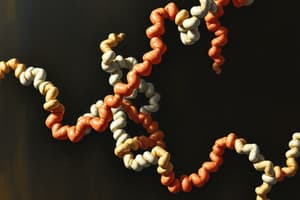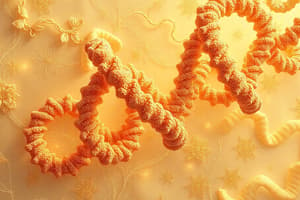Podcast
Questions and Answers
How does the orientation of R-groups in B-strands affect the structure's properties?
How does the orientation of R-groups in B-strands affect the structure's properties?
R-groups in B-strands oriented on the same side of the plane affect the amphipathic nature, leading to distinct hydrophobic and hydrophilic faces.
What characterizes amphipathic B-sheets?
What characterizes amphipathic B-sheets?
Amphipathic B-sheets are characterized by having both hydrophobic and hydrophilic faces due to the polarity differences of R-groups.
What role do adjacent R-groups play in defining the flatness of B-sheets?
What role do adjacent R-groups play in defining the flatness of B-sheets?
Adjacent R-groups being oriented in the same direction aids in the formation of a flat structure necessary for B-sheets.
Why are flat B-sheets considered rare, and what is expected regarding their hydrophobic face?
Why are flat B-sheets considered rare, and what is expected regarding their hydrophobic face?
How does the zigzag backbone of B-sheets contribute to their overall structure?
How does the zigzag backbone of B-sheets contribute to their overall structure?
Why do cis and trans proline have much lower energy compared to other amino acids?
Why do cis and trans proline have much lower energy compared to other amino acids?
What main secondary structures are commonly formed in proteins?
What main secondary structures are commonly formed in proteins?
How do peptide bonds contribute to the net dipole moment in protein structures?
How do peptide bonds contribute to the net dipole moment in protein structures?
Explain the role of intrachain hydrogen bonds in alpha-helices.
Explain the role of intrachain hydrogen bonds in alpha-helices.
What structural feature allows beta-strands to form beta-sheets?
What structural feature allows beta-strands to form beta-sheets?
In what way do loops and turns contribute to protein structure?
In what way do loops and turns contribute to protein structure?
Why is the cis conformer of proline rarely seen in protein structures?
Why is the cis conformer of proline rarely seen in protein structures?
Describe how a continuous set of amino acids interacts within an alpha-helix.
Describe how a continuous set of amino acids interacts within an alpha-helix.
How do the R-groups on the helical wheel influence the properties of the cc-helix?
How do the R-groups on the helical wheel influence the properties of the cc-helix?
What role do Glu and Lys play in stabilizing the helix?
What role do Glu and Lys play in stabilizing the helix?
Describe how the orientation of R4 impacts the helix function.
Describe how the orientation of R4 impacts the helix function.
What is the significance of having polar and non-polar R-groups facing opposite directions in the helical structure?
What is the significance of having polar and non-polar R-groups facing opposite directions in the helical structure?
How does the position of residues influence the stability of the helix?
How does the position of residues influence the stability of the helix?
What is the impact of the helical wheel arrangement on helix-turn-helix motifs?
What is the impact of the helical wheel arrangement on helix-turn-helix motifs?
Explain how amino acid hydrophobicity can influence the folding patterns of the cc-helix.
Explain how amino acid hydrophobicity can influence the folding patterns of the cc-helix.
Why is the interaction between residues critical for the formation of a stable 3D shape?
Why is the interaction between residues critical for the formation of a stable 3D shape?
What is the significance of glycine in the context of B-strands?
What is the significance of glycine in the context of B-strands?
How do proline residues influence the structure of B-turns in proteins?
How do proline residues influence the structure of B-turns in proteins?
What role do phi angles play in peptide bonding, particularly in alpha-helices?
What role do phi angles play in peptide bonding, particularly in alpha-helices?
Why are hydrogen bonds not critical for the stability of certain residues in B-strands?
Why are hydrogen bonds not critical for the stability of certain residues in B-strands?
What does the term 'antiparallel B-strands' refer to, and why is it important?
What does the term 'antiparallel B-strands' refer to, and why is it important?
How do alternating polar and non-polar amino acids contribute to the formation of B-sheets?
How do alternating polar and non-polar amino acids contribute to the formation of B-sheets?
What limitation is associated with the use of proline in protein structures?
What limitation is associated with the use of proline in protein structures?
Why is the presence of glycine often preferred at the 2nd and 3rd residue positions in B-turns?
Why is the presence of glycine often preferred at the 2nd and 3rd residue positions in B-turns?
What is the significance of interdigitation between Ala and Gly in sheet packing?
What is the significance of interdigitation between Ala and Gly in sheet packing?
How do the structural features of coiled coils in CcKeratin differ from those in Collagen?
How do the structural features of coiled coils in CcKeratin differ from those in Collagen?
In what way does the presence of hydrophobic amino acids affect the properties of proteins like CcKeratin?
In what way does the presence of hydrophobic amino acids affect the properties of proteins like CcKeratin?
Describe the flexibility of B-sheets and how it differs from other protein structures.
Describe the flexibility of B-sheets and how it differs from other protein structures.
What role do disulfide bonds play in determining the toughness of CcKeratin?
What role do disulfide bonds play in determining the toughness of CcKeratin?
How does the variable degree of crosslinking in Collagen influence its structural properties?
How does the variable degree of crosslinking in Collagen influence its structural properties?
What can be inferred about the flexibility of fibroin compared to CcKeratin and Collagen?
What can be inferred about the flexibility of fibroin compared to CcKeratin and Collagen?
Explain how variations in amino acids contribute to the diversity of protein families mentioned.
Explain how variations in amino acids contribute to the diversity of protein families mentioned.
Flashcards are hidden until you start studying
Study Notes
Proline
- Cis and trans proline have much less energy than other amino acids due to rigidity.
- Trans-proline is also unfavorable, allowing for the formation of cis-proline, but cis conformers are never seen in other amino acids.
Protein Structure
- Two main structures:
- α-Helix
- β-Strands/Sheets
- Loops and turns are also important in protein structure.
- Net dipole:
- The electric dipole of a peptide bond is transmitted along an α-helix through intrachain H-bonds.
- α-Helix:
- Spring-like, spiral shape.
- H-bond:
- Parallel to the helix axis.
- Occurs from the rest of the CO group to the NH group four residues ahead.
- Affects α-helix function.
- Continuous set of amino acid residues project outwards perpendicular to the helix axis.
Helical Wheel: α-Helix
- 3.6 residues/turn.
- R-groups on each side of the wheel influence α-helix properties.
- R, Rs and Ro are hydrophobic.
- Ry, Ra, Ro, Re are hydrophilic.
- Important feature for folding protein
- If residues 1 and 4 are residues that interact, they form a salt bridge.
- This can stabilize the α-helix.
- Allows for formation of 3D shape.
β-Sheets
- R-groups on adjacent strands but in the same position on the sheet are oriented in the same direction.
- Amphipathic β-Sheets:
- Have hydrophobic and hydrophilic faces.
- Zigzag backbone could be amphipathic if two R groups have different polarities.
- Flat β-sheets are rare.
- Hydrophobic face would be buried away from the aqueous environment.
- Linker close in on the sea of 2 β-strands.
Glycine
- More important than achiral C, because it is the only amino acid with a small R group, and it is non-chiral.
- Allows for tightening of the backbone structure.
Proline
- Critical for β-turns.
- Allows for tight turns in the backbone structure.
- Found in the 2nd and 3rd residue of β-turns.
- 1st and 4th residues are often Pro, which form H-bonds.
- Restricting phi(0) angle.
- Found in other regions, but not in α-helices.
Other Protein Structure:
- Glycine and Alanine packing:
- Gly pack together as Ala align.
- Allows for close packing of sheets.
- Side chains of Ala have a larger space between them.
- This allows for flexibility of stacked β-sheets.
- β-Structure is extended but still has a level of flexibility.
- It cannot be stretched.
Protein Families
- α-Keratin:
- Two α-helices from left-handed supercoil forms a right-handed supercoil.
- This is called a coiled coil.
- Heptad repeat: a & d positions are hydrophobic.
- Not extended and cannot stretch.
- Variable toughness depends on the degree of disulfide bonds.
- Collagen:
- Three left-handed helices that form a right-handed supercoil.
- (G-X-Y)-(G-X-Y)-(G-X-Y) repeat.
- Extended but it cannot stretch.
- Rigid due to many crosslinks between collagen molecules.
- Fibroin
- β-strands that form β-sheets.
- Extended but cannot stretch.
- Flexible due to the lack of covalent cross-links.
- All of these are found in families with variations in amino acids.
Studying That Suits You
Use AI to generate personalized quizzes and flashcards to suit your learning preferences.




